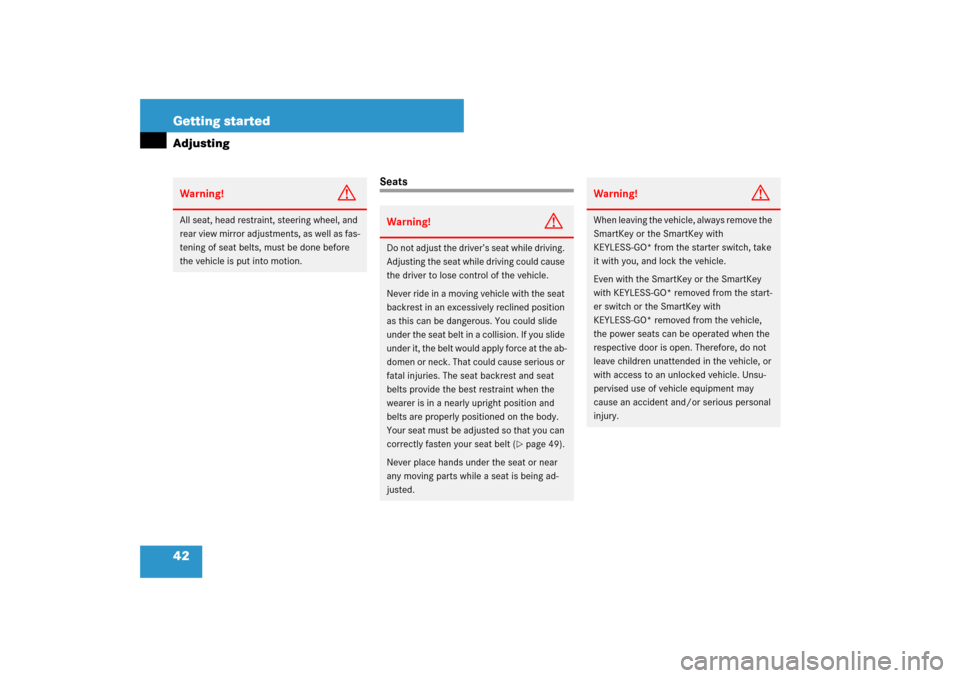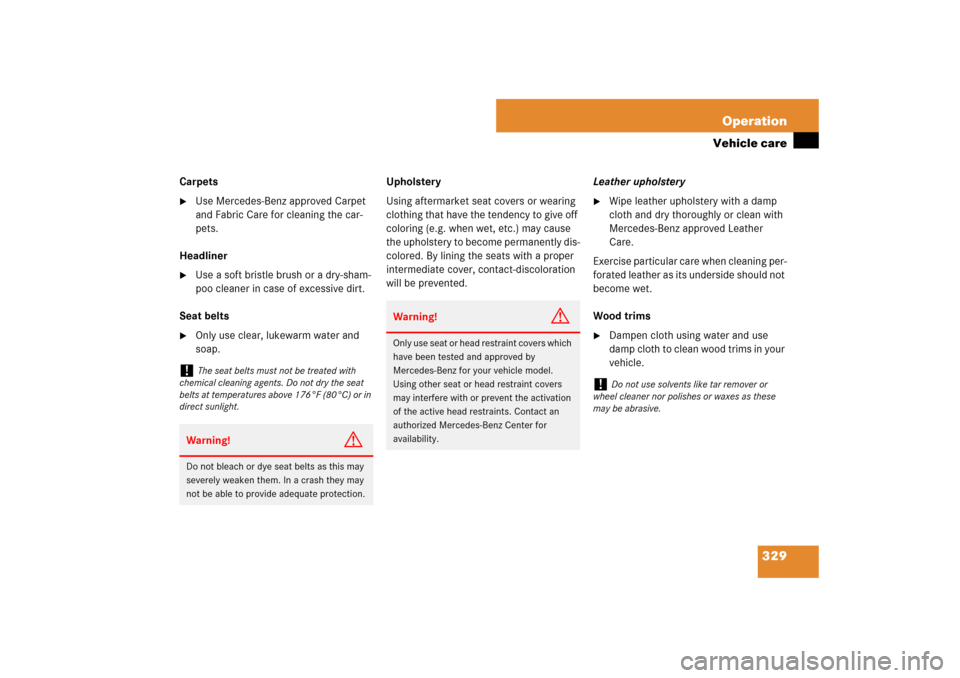Page 43 of 473

42 Getting startedAdjusting
Seats
Warning!
G
All seat, head restraint, steering wheel, and
rear view mirror adjustments, as well as fas-
tening of seat belts, must be done before
the vehicle is put into motion.
Warning!
G
Do not adjust the driver’s seat while driving.
Adjusting the seat while driving could cause
the driver to lose control of the vehicle.
Never ride in a moving vehicle with the seat
backrest in an excessively reclined position
as this can be dangerous. You could slide
under the seat belt in a collision. If you slide
under it, the belt would apply force at the ab-
domen or neck. That could cause serious or
fatal injuries. The seat backrest and seat
belts provide the best restraint when the
wearer is in a nearly upright position and
belts are properly positioned on the body.
Your seat must be adjusted so that you can
correctly fasten your seat belt (
�page 49).
Never place hands under the seat or near
any moving parts while a seat is being ad-
justed.
Warning!
G
When leaving the vehicle, always remove the
SmartKey or the SmartKey with
KEYLESS-GO* from the starter switch, take
it with you, and lock the vehicle.
Even with the SmartKey or the SmartKey
with KEYLESS-GO* removed from the start-
er switch or the SmartKey with
KEYLESS-GO* removed from the vehicle,
the power seats can be operated when the
respective door is open. Therefore, do not
leave children unattended in the vehicle, or
with access to an unlocked vehicle. Unsu-
pervised use of vehicle equipment may
cause an accident and/or serious personal
injury.
Page 86 of 473

85 Safety and Security
Occupant safety
�
A child in a rear-facing child restraint on
the passenger seat will be seriously in-
jured or even killed if the passenger
front air bag inflates in a collision which
could occur under some circumstances,
even with the air bag technology in-
stalled in your vehicle.
�
If you install a rear-facing child restraint
on the passenger seat, make sure that
the 5/indicator lamp is illumi-
nated, indicating that the passenger
front air bag is deactivated. Should the
5/ indicator lamp not illuminate
or go out while the restraint is installed,
please check installation. Periodically
check the 5/ indicator lamp
while driving to make sure the
5/indicator lamp is illuminated.
If the 5/ indicator lamp goes out
or remains out, do not transport a child
on the passenger seat until the system
has been repaired. A child in a rear-fac-
ing child restraint on the passenger seat
will be seriously injured or even killed if
the passenger front air bag inflates.
�
If you place a child in a forward-facing
child restraint on the passenger seat,
move the seat as far back as possible,
use the proper child restraint recom-
mended for the age, size and weight of
the child, and secure child restraint with
the vehicle’s seat belt according to the
child seat manufacturer’s instructions.
For children larger than the typical
12-month-old child, the passenger front
air bag may or may not be activated
(�page 74).
Warning!
G
Infants and small children should never
share a seat belt with another occupant.
During an accident, they could be crushed
between the occupant and seat belt.
A child’s risk of serious or fatal injuries is
significantly increased if the child restraints
are not properly secured in the vehicle and
the child is not properly secured in the child
restraint.
Warning!
G
Children too big for a toddler restraint must
ride in seats using regular seat belts. Posi-
tion the shoulder belt across chest and
shoulder, not face or neck. A booster seat
may be necessary to achieve proper belt po-
sitioning for children over 41 lbs until they
reach a height where a lap/shoulder belt fits
properly without a booster.
When the child restraint is not in use,
remove it from the vehicle or secure it with
the seat belt to prevent the child restraint
from becoming a projectile in the event of
an accident.
Do not leave children unattended in the ve-
hicle, even if the children are secured in a
child restraint system. Unsupervised chil-
dren in a child restraint system may use ve-
hicle equipment and cause an accident
and/or serious personal injury.
Page 330 of 473

329 Operation
Vehicle care
Carpets�
Use Mercedes-Benz approved Carpet
and Fabric Care for cleaning the car-
pets.
Headliner
�
Use a soft bristle brush or a dry-sham-
poo cleaner in case of excessive dirt.
Seat belts
�
Only use clear, lukewarm water and
soap.Upholstery
Using aftermarket seat covers or wearing
clothing that have the tendency to give off
coloring (e.g. when wet, etc.) may cause
the upholstery to become permanently dis-
colored. By lining the seats with a proper
intermediate cover, contact-discoloration
will be prevented.Leather upholstery
�
Wipe leather upholstery with a damp
cloth and dry thoroughly or clean with
Mercedes-Benz approved Leather
Care.
Exercise particular care when cleaning per-
forated leather as its underside should not
become wet.
Wood trims
�
Dampen cloth using water and use
damp cloth to clean wood trims in your
vehicle.
!
The seat belts must not be treated with
chemical cleaning agents. Do not dry the seat
belts at temperatures above 176°F (80°C) or in
direct sunlight.
Warning!
G
Do not bleach or dye seat belts as this may
severely weaken them. In a crash they may
not be able to provide adequate protection.
Warning!
G
Only use seat or head restraint covers which
have been tested and approved by
Mercedes-Benz for your vehicle model.
Using other seat or head restraint covers
may interfere with or prevent the activation
of the active head restraints. Contact an
authorized Mercedes-Benz Center for
availability.
!
Do not use solvents like tar remover or
wheel cleaner nor polishes or waxes as these
may be abrasive.